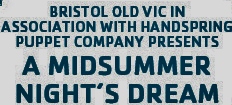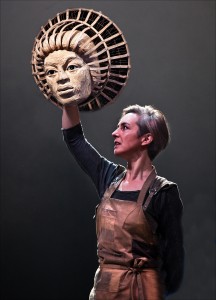WELL MET BY MOONLIGHT
Some plays are just too good to be easily staged. In my experience Shakespeare’s most beloved comedy, A Midsummer Night’s Dream, has defied more directors than it has rewarded. The thing requires so much attention, so much love, so much effort! You’ve got to create living worlds for three sets of mortal fools, and then you’ve got to make a host of fairies live inside a universe wonderful enough to support them all. Almost every time I’ve seen it, big chunks of the story bring me to yawning, as the production falls out of love with some element or other.
There are a lot of elements.
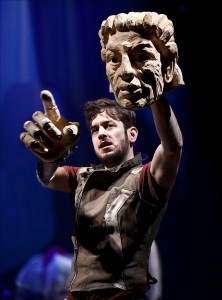 Untidily synopsized: Theseus, Duke of Athens (David Ricardo-Pearce) and Hippolyta, Queen of the Amazons (Saskia Portway) are about to be married. Theseus commands noblewoman Hermia (Akiya Henry) to marry Demetrius (Kyle Lima), according to her father’s wishes and the law of Athens. Yet Hermia loves Lysander (Alex Felton), who loves her too. Hermia’s friend Helena (Naomi Cranston) loves Demetrius, who, besotted by Hermia, does not love Helena back. Lysander and Hermia run away together and get lost in the woods; Demetrius follows to steal Hermia back, and Helena follows because she cannot be away from Demetrius. In the woods two odd companies await the lovers. The tradesmen known as the mechanicals – Peter Quince the carpenter (Colin Michael Carmichael), Snug the joiner (Saikat Ahamed), Snout the tinker (Fionn Gill), Flute the bellows-mender (Christopher Keegan), Starveling the tailor (Lucy Tuck), and Bottom the weaver (Miltos Yerolemou) – haplessly prepare a terrible play they are hopeful to present at the Duke’s wedding. The fairies are about, too, notably King Oberon (Ricardo-Pearce, again) and Queen Titania (Portway, again), who have come to Athens to honor the Duke’s wedding but are in the midst of an argument over one of their wedding presents. Oberon sets his mischievous sprite, Puck (Saikat Ahamed, Fionn Gill, Lucy Tuck), to punish Titania by charming her to fall in love with the first hideous thing she sees upon waking. Puck makes her fall in love with the pretentious and ridiculous Bottom, having first transformed Bottom into an ass. Puck also is set to make Demetrius fall in love with Helena; instead, Puck accidentally makes Lysander fall in love with her. And all that has to get fixed.
Untidily synopsized: Theseus, Duke of Athens (David Ricardo-Pearce) and Hippolyta, Queen of the Amazons (Saskia Portway) are about to be married. Theseus commands noblewoman Hermia (Akiya Henry) to marry Demetrius (Kyle Lima), according to her father’s wishes and the law of Athens. Yet Hermia loves Lysander (Alex Felton), who loves her too. Hermia’s friend Helena (Naomi Cranston) loves Demetrius, who, besotted by Hermia, does not love Helena back. Lysander and Hermia run away together and get lost in the woods; Demetrius follows to steal Hermia back, and Helena follows because she cannot be away from Demetrius. In the woods two odd companies await the lovers. The tradesmen known as the mechanicals – Peter Quince the carpenter (Colin Michael Carmichael), Snug the joiner (Saikat Ahamed), Snout the tinker (Fionn Gill), Flute the bellows-mender (Christopher Keegan), Starveling the tailor (Lucy Tuck), and Bottom the weaver (Miltos Yerolemou) – haplessly prepare a terrible play they are hopeful to present at the Duke’s wedding. The fairies are about, too, notably King Oberon (Ricardo-Pearce, again) and Queen Titania (Portway, again), who have come to Athens to honor the Duke’s wedding but are in the midst of an argument over one of their wedding presents. Oberon sets his mischievous sprite, Puck (Saikat Ahamed, Fionn Gill, Lucy Tuck), to punish Titania by charming her to fall in love with the first hideous thing she sees upon waking. Puck makes her fall in love with the pretentious and ridiculous Bottom, having first transformed Bottom into an ass. Puck also is set to make Demetrius fall in love with Helena; instead, Puck accidentally makes Lysander fall in love with her. And all that has to get fixed.
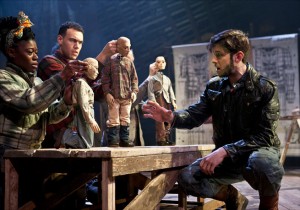 Hilarity rarely ensues, because there’s too much going on for most directors to make me care about more than one or two of these plot threads. Usually the mechanicals get short shrift, and with reason: their connection to the plot is tangential at best. Their thematic value is often overlooked in the whirling storm of stories. And too frequently the lovers are presented and played as idiots whose lives are rightly ruled by royals and mystical agents. And those rulers are almost invariably portrayed as benevolent omnipotents with no real problems of their own. And the fairies, mostly, look and act exactly like people, only sometimes they fly, á la Peter Pan. Which gets old fast.
Hilarity rarely ensues, because there’s too much going on for most directors to make me care about more than one or two of these plot threads. Usually the mechanicals get short shrift, and with reason: their connection to the plot is tangential at best. Their thematic value is often overlooked in the whirling storm of stories. And too frequently the lovers are presented and played as idiots whose lives are rightly ruled by royals and mystical agents. And those rulers are almost invariably portrayed as benevolent omnipotents with no real problems of their own. And the fairies, mostly, look and act exactly like people, only sometimes they fly, á la Peter Pan. Which gets old fast.
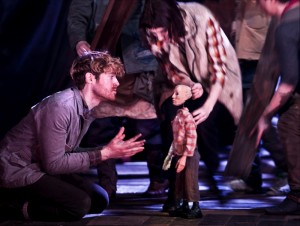 England’s Bristol Old Vic and South Africa’s Handspring Puppet Company have solved the latter problem by casting largely found-object puppets as fairies. They’ve covered the other issues by casting the best possible actors as people, and by the foresight of having as director Tom Morris, Tony Award-winner for co-directing the international hit War Horse (also in collaboration with Handspring). In his hands, this most complicated of plays is a unified delight. In this production, there are no perfect agents; when Puck mentions what fools these mortals be, he is on the way to screwing up most of his own errands. My attention wavered occasionally during the latter acts, but it’s Shakespeare’s fault more than the director’s: this is a play with about nineteen endings. Each plot line wraps itself up at least twice, and then those characters come back for a complete act, plus, of falling action. But it’s never looked so good as it does here, and my annoyance in every case was fleeting, replaced immediately by wonder and joy.
England’s Bristol Old Vic and South Africa’s Handspring Puppet Company have solved the latter problem by casting largely found-object puppets as fairies. They’ve covered the other issues by casting the best possible actors as people, and by the foresight of having as director Tom Morris, Tony Award-winner for co-directing the international hit War Horse (also in collaboration with Handspring). In his hands, this most complicated of plays is a unified delight. In this production, there are no perfect agents; when Puck mentions what fools these mortals be, he is on the way to screwing up most of his own errands. My attention wavered occasionally during the latter acts, but it’s Shakespeare’s fault more than the director’s: this is a play with about nineteen endings. Each plot line wraps itself up at least twice, and then those characters come back for a complete act, plus, of falling action. But it’s never looked so good as it does here, and my annoyance in every case was fleeting, replaced immediately by wonder and joy.
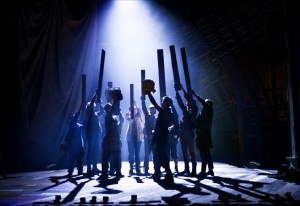 There’s a gorgeous and expensive looking lot of lighting and non-representational set filling the Broad Stage (Philip Gladwell and Vicki Mortimer, respectively), and a few of the puppets clearly required some serious mechanical engineering (Handspring’s Adrian Kohler and Basil Jones). But the real show here could be done for the cost of a trip to a junk shop, because it’s all about imagination. The problem of Puck is solved in so ingenious and startling a manner that I will not mention its nature, and the problem of Bottom’s appearance as an ass is managed so literally that the answer seems as if it should have been obvious to us for the past 400 years, because it’s not puppets or lights that make a show. It’s those solutions. It’s that director who invests in the text and reaps dividends of revelation and thrill.
There’s a gorgeous and expensive looking lot of lighting and non-representational set filling the Broad Stage (Philip Gladwell and Vicki Mortimer, respectively), and a few of the puppets clearly required some serious mechanical engineering (Handspring’s Adrian Kohler and Basil Jones). But the real show here could be done for the cost of a trip to a junk shop, because it’s all about imagination. The problem of Puck is solved in so ingenious and startling a manner that I will not mention its nature, and the problem of Bottom’s appearance as an ass is managed so literally that the answer seems as if it should have been obvious to us for the past 400 years, because it’s not puppets or lights that make a show. It’s those solutions. It’s that director who invests in the text and reaps dividends of revelation and thrill.
It’s an enormously physical production, the actors constantly in motion, if not playing one of two or three parts, then being subsumed into some multi-player gesture (movement director: Andrew Dawson). These choices are all bold, and they’re not set in stone: less than a year old, this production has already jettisoned some of its puppets and a few other gestures from its Bristol run. One of my favorite things about any show is that it knows art is never quite finished.
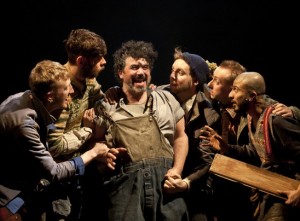 Director Morris isn’t terribly interested in the iambic pentameter of the lines, and I’m a little torn on this one: those of his actors who know how to deliver the rhythms as written are allowed to do so (particularly outstanding work from Alex Felton and David Ricardo-Pearce), and these tend to be the same actors who can be heard throughout the imperfectly acoustic Broad house. Others of his actors, particularly Akiya Henry and Naomi Cranston, are allowed to break up the text for not particularly effective naturalistic line-readings. It doesn’t really matter, because both of those women deliver exciting and satisfying characterizations regardless. And it’s not as if I missed any of this delicious poetry; but then, I was sitting down front. It still doesn’t really matter because (and this is as true of a Shakespeare show as any, given the gigantic and important themes with which a major playwright works) the words aren’t all that matter. It’s a show. They show us. And we see.
Director Morris isn’t terribly interested in the iambic pentameter of the lines, and I’m a little torn on this one: those of his actors who know how to deliver the rhythms as written are allowed to do so (particularly outstanding work from Alex Felton and David Ricardo-Pearce), and these tend to be the same actors who can be heard throughout the imperfectly acoustic Broad house. Others of his actors, particularly Akiya Henry and Naomi Cranston, are allowed to break up the text for not particularly effective naturalistic line-readings. It doesn’t really matter, because both of those women deliver exciting and satisfying characterizations regardless. And it’s not as if I missed any of this delicious poetry; but then, I was sitting down front. It still doesn’t really matter because (and this is as true of a Shakespeare show as any, given the gigantic and important themes with which a major playwright works) the words aren’t all that matter. It’s a show. They show us. And we see.
The big thing is whether a show encompasses you, charms you out of your seat and into itself. As Tom Morris says in the program notes, “There is nothing in the least ‘mere’ about the imagination, when you enter a world of spirits, fear, and people who desire each other so wildly they can barely keep their clothes on. That’s right. I mean a theatre.”
A Midsummer Night’s Dream
Bristol Old Vic /
Handspring Puppet Company
Broad Stage
1310 11th St. in Santa Monica
scheduled to end on April 19, 2014
for tickets, call 310.434.3200
or visit www.thebroadstage.com
